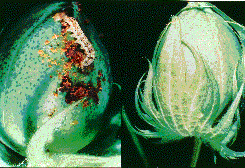Bacillus thuringiensis is a bacterium that parasitizes the caterpillars of some harmful moths and butterflies. Spraying or dusting plants with spores of this bacterium appear to be environmentally safe ways to attack such pests as the gypsy moth, the tent caterpillar, and the tobacco hornworm (which also attacks tomatoes). The bacteria kill by a toxin which they secrete. The gene for this toxin has been introduced into some crop plants in an effort to protect them from insect attack without the need for spraying.

On the left is a cotton boll being attacked by a cotton bollworm. The cotton plant that produced the boll on the right contains and expresses the gene for the Bt toxin. The gene was introduced into the plant by genetic engineering. (Image courtesy of the Monsanto Corp.)
| How transgenic plants are made. |
Transgenic cotton and corn (maize) containing the gene for Bt toxin were widely planted for the first time in 1996. By 2004, these crops had been planted on some 50 million acres (20x106 hectares) worldwide. In the United States over 70% of the cotton planted and 40% of the corn planted is now with transgenic varieties.
Tests in China of rice transgenic for Bt toxin has shown improved crop yields with greatly-reduced need for chemical pesticides.
| External Link |
| Transgenic Crops (site maintained by Colorado State) |
| Please let me know by e-mail if you find a broken link in my pages.) |
B. thuringiensis appears to be the same organism as Bacillus cereus, a usually harmless soil organism, and Bacillus anthracis, the cause of anthrax.
What gives them their distinctive properties are the genes encoded by the plasmids they contain.
| Welcome&Next Search |